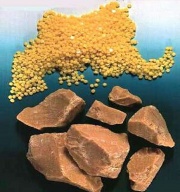Difference between revisions of "Candelilla wax"
m (Text replace - "== Authority ==" to "== Sources Checked for Data in Record ==") |
|||
| Line 41: | Line 41: | ||
| − | == | + | == Sources Checked for Data in Record == |
* R. J. Gettens, G.L. Stout, ''Painting Materials, A Short Encyclopaedia'', Dover Publications, New York, 1966 Comment: melting range 67-71 C | * R. J. Gettens, G.L. Stout, ''Painting Materials, A Short Encyclopaedia'', Dover Publications, New York, 1966 Comment: melting range 67-71 C | ||
Revision as of 14:29, 29 April 2016
Description
A yellowish-brown vegetable Wax exuded from the leaves and stems of succulent shrubs, Euphorbia antisyphilitica and Pedilanthus pavinia, native to northern Mexico and the southwestern U.S. Candelilla wax is obtained by boiling the leaves and stems in Water and Sulfuric acid. Candelilla is composed of hydrocarbons, centered around C31 with smaller amounts of esters and triterpenoids. It is a dark brown wax that is hard and brittle with little tack. Candelilla wax is an all-purpose wax used for Leather dressing, polishes, cements, Ebonite varnishes, candles, Sealing wax, paper sizing, waterproofing, metal casting, and insect-proofing.
Synonyms and Related Terms
Copernicia cerifera; Corypha cerifera; Carnaubawachs (Deut.); carnauba wosk (Pol.); cera carnauba (Esp., It.); Brazil wax; ceara wax; olho wax; flora wax; pahla wax; chalky wax; Butcher's wax
Other Properties
Soluble in chloroform, turpentine, carbon tetrachloride, trichloroethylene, toluene and alkalis. Insoluble in water.
Saponification value = 35 - 86; Iodine number = 14-37; Acid number = 12-20
Total % alcohols and hydrocarbons = 65-75
| CAS | 8006-44-8 |
|---|---|
| Melting Point | 67-71 |
| Density | 0.950-0.990 |
| Refractive Index | 1.4555 |
Hazards and Safety
Combustible.
Comparisons
Sources Checked for Data in Record
- R. J. Gettens, G.L. Stout, Painting Materials, A Short Encyclopaedia, Dover Publications, New York, 1966 Comment: melting range 67-71 C
- Ralph Mayer, A Dictionary of Art Terms and Techniques, Harper and Row Publishers, New York, 1969 (also 1945 printing)
- Matt Roberts, Don Etherington, Bookbinding and the Conservation of Books: a Dictionary of Descriptive Terminology, U.S. Government Printing Office, Washington DC, 1982 Comment: softening range 64-68C
- G.S.Brady, Materials Handbook, McGraw-Hill Book Co., New York, 1971 Comment: p. 136; melting point=67-70C, iodine value=37, saponification value=45-65
- John S. Mills, Raymond White, The Organic Chemistry of Museum Objects, Butterworth Heineman, London, 2nd ed., 1994
- A History of Technology, Charles Singer, E.J. Holmyard, A.R. Hall (eds.), Clarendon Press, Oxford, Volume 1: From Early times to Fall of Ancient Empires, 1954
- Wikipedia, the free encyclopedia, at http://www.wikipedia.com Comment: http://en.wikipedia.org/wiki/Candelilla_wax (Accessed Feb. 10, 2006)
- CRC Handbook of Chemistry and Physics, Robert Weast (ed.), CRC Press, Boca Raton, Florida, v. 61, 1980 Comment: melting point=67-69C, density=0.982-0.986, ref. index=1.454-1.463, iodine value=14.4-20.4, acid value=12.7-18.1, saponification value=35-86
- Richard S. Lewis, Hawley's Condensed Chemical Dictionary, Van Nostrand Reinhold, New York, 10th ed., 1993
- Random House, Webster's Encyclopedic Unabridged Dictionary of the English Language, Grammercy Book, New York, 1997
- The American Heritage Dictionary or Encarta, via Microsoft Bookshelf 98, Microsoft Corp., 1998
- Art and Architecture Thesaurus Online, http://www.getty.edu/research/tools/vocabulary/aat/, J. Paul Getty Trust, Los Angeles, 2000
